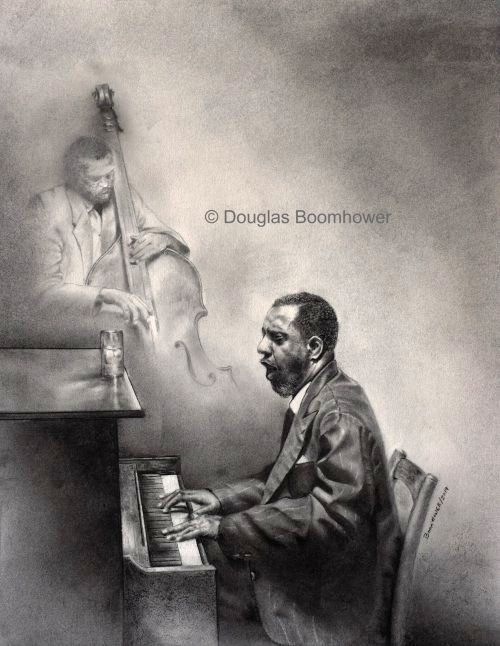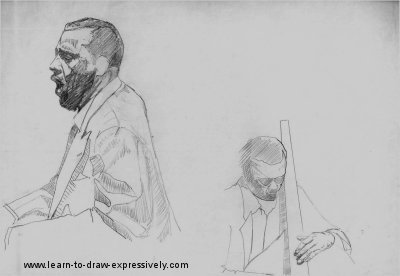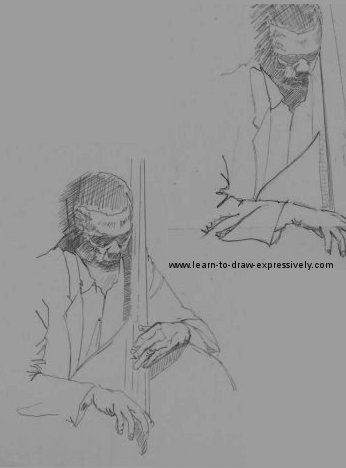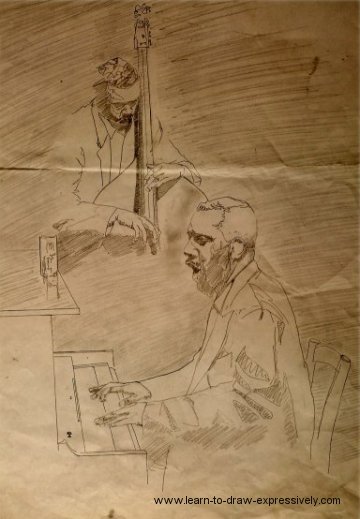Charcoal Drawings
... the power of black and white drawings
Charcoal drawings work well if you have a preference for the power of black and white drawings. Because of its immediacy, drawing has always been my favorite artistic discipline.


Charcoal on paper allows me to use my drawing skills and to explore the entire spectrum from black to white.

Before beginning with the charcoal, I do a series of preliminary drawings in pencil.
I’ve included some of these drawing pencil sketches here.

After completing my detailed pencil drawings, I trace the final preliminary drawing onto Meridian paper, and then begin working in charcoal.
I use my light table to do the tracing.
Of course, this was a large white piece of paper when I started (18 x 24 inches).
It takes time and patience to darken a piece of paper that size with charcoal, and maintain even tones.
I used soft charcoal to do this, and then carefully and patiently rubbed the paper with tissues, brushes, blending stumps, and my fingers. (If your hands perspire, don’t use your fingers because the oil in your fingers will stain the paper.)
Charcoal Drawing Paper - Observations
You have to get to know the drawing papers you are working with so you will know how much smudging each can withstand. I like using Meridian Paper. It has a strong tooth, yet its smooth enough that you can work in detail.
A lot of charcoal dust is created when you are working with charcoal, so be careful to keep your paper clean as you work. Despite the fact that lots of soft, dark charcoal has been used, notice how clear and clean this drawing appears.
More Observations
First, look at the mood of the piece. The overall charcoal drawing is dark but there are highlights throughout. The contrast of these lights and darks adds drama and power to the piece.
Notice how alive the two figures appear to be. Gesture and contour drawing are the basis of learning to make your drawings come to life.

The musicians' faces are expressive, as are the hands.
Although contour lines are the basis for both faces, those lines disappear as I begin applying the charcoal in a “painterly” way, (that is, I’m applying charcoal in areas of lights and darks.)
The piano player’s hands are done in lights and darks, yet they also are based on the underlying contour lines with which I drew them.
The same can be said of the bass player’s hands.
The piano player’s suit is a very concentrated study in clothing.
Note the following:
- The folds and shadows in the suit
- The creases in the lapel
- The sharp contrast between the lapel and the dark areas around it
- Highlight on the shirt collar, and the pocket handkerchief
- The pin stripes in the suit (done with a kneaded eraser)
Realistic texture is an important part of all of my drawings. By looking at the picture you can almost feel the difference in fabric between the suits of the two figures.
Charcoal Drawing Techniques
The pianist’s suit appears smooth (I used brushes), while the bass player’s suit has a rougher looking fabric. I achieved this look by very lightly rubbing the side of a charcoal pencil across the paper. If done lightly enough, the charcoal will catch only the tooth of the paper, thereby creating a rough look. This is one of the charcoal drawing techniques I use in various situations.
Return from Charcoal Drawings to Drawing Technique
Return to Learn-To-Draw-Expressively Home Page




